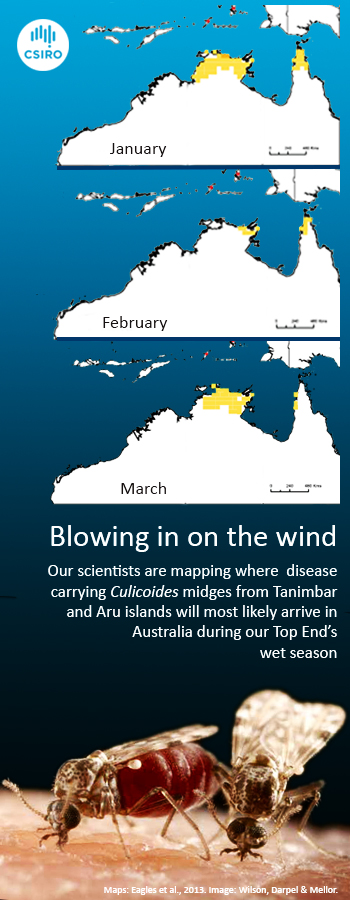
Image: Shutterstock
By Emma Pyers
Picture this – it’s a windy day in Northern Australia; in fact it’s a northerly wind. What are your initial thoughts? Maybe heading to the beach with the family, hosting a BBQ or spending time outside with your canine friend? But did you think about the risks these winds pose to our country’s biosecurity status?
If not, that’s OK because that’s what our scientists are here for – to help find solutions to protecting our environment and people from nasty pest and disease threats.
Currently the biggest biosecurity threat to Australia comes from the import of animals, plants, seeds and food that carry pests or pathogens.
So it makes sense that most of our surveillance effort goes into detecting these potential biosecurity threats at air and marine ports, and using our quarantine system for imported animals, although this still leaves open another ‘pathway’ for these nasties to use.
It’s on the wind.
It’s not as common as the direct import pathway, but it’s more concerning as it’s out of our immediate control.
So, we’re turning to mathematics and computer modelling to develop surveillance systems that can predict when and where pests and pathogens might be blown into, and from, Australia.

Been hot air ballooning? Then you’ve experienced travelling with air layers and currents. Image: Zurijeta/Shutterstock
Traditionally wind trajectories have been used to show wind direction, but transport on the wind is more complex, as the pests and pathogens are also taken vertically. The higher they are taken, the further they can travel.
Fortunately this is an area of great significance to atmospheric physicists, as they are interested in predicting things like how pollutants are dispersed in the air by chimneys, and how radiation might disperse following a nuclear accident.
This has led them to use a combination of mathematics and computer simulation to represent transport of particles in the atmosphere. There are now a number of computer applications that can do the hard work of combining the climate and weather data with the maths and physics of wind dispersion.

However, pest or pathogen dispersion is different to dust or pollutant dispersions, as living organisms respond differently within the atmosphere. They might die if it’s too hot or cold, if the wind is too turbulent, or even if they’re susceptible to ultra-violet light. All these organism-specific parameters need to be taken into account on top of standard dispersion modelling approaches to establish if there is a biosecurity risk or not.
It’s a challenge to bring these important elements together and make optimal decisions about when and where to do surveillance for wind-borne threats, even allowing for a high performance computer to analyse the data.
We’re working to solve this problem for all the relevant biosecurity domains interested in wind-borne spread, for example plant, animal and human health.
We are in the process of building a web-based tool that will link to the Bureau of Meteorology’s high-performance computing. This new application is called the Tool for Assessing Pest or Pathogen Airborne Spread, also known as TAPPAS (sorry, it’s not Spanish cuisine).
We expect TAPPAS to be ready for government, industry and research agencies interested in predicting and responding to airborne biosecurity threats for a ‘user acceptance testing” workshop in around 12-18 months time.
Our very own Peter Durr is presenting a talk on TAPPAS at the Biosecurity and Bioinvasion workshop tomorrow at CSIRO Discovery in Canberra. CSIRO is co-hosting this event, which is part of the International Year of the Mathematics of Planet Earth, with AMSI, ANU and DAFF.


28th March 2021 at 5:46 pm
great blogs outstanding information…
22nd March 2021 at 2:03 am
The post is very interesting, thanks to the author, would you like to discuss with me how to make this post interesting?
22nd May 2015 at 12:07 am
Mosquitoes, flea and flies – seriously some of the most annoying and ‘unaustralia’ creatures!
12th September 2013 at 3:37 pm
Reblogged this on earleenblog.